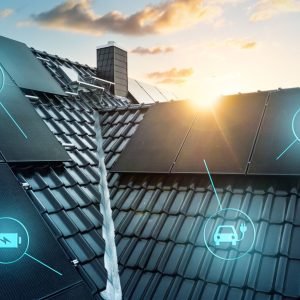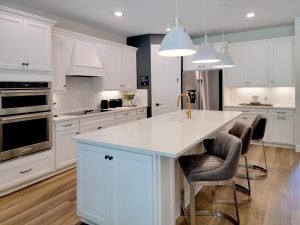Last Updated on November 21, 2025 by teamobn
Contents
- 1 Quick Answer
- 2 Introduction
- 3 Smart Roofing Systems: A New Standard in Home Performance
- 4 Energy-Efficient Roofing: Beyond the Basics
- 5 Solar Roof Technology: Power Where You Need It Most
- 6 Smart Home Roof Solutions: Intelligence Built In
- 7 Green Roofing Systems: Nature as a Building Material
- 8 Making the Right Choice for Your Home
Quick Answer
Modern homes are increasingly designed with long-term comfort and sustainability in mind, and the roof plays a pivotal role in that equation. A well-constructed roof doesn’t just shield against weather – it influences indoor temperature, reduces strain on heating and cooling systems, and can even extend the lifespan of other building components. Materials, slope, ventilation, and installation quality all contribute to how effectively a roof performs over time.
Homeowners who prioritize thoughtful design and durable craftsmanship often see measurable reductions in utility costs and fewer repairs over the years. The right approach balances function, durability, and environmental impact without relying on gimmicks.
Introduction
As homeowners look beyond aesthetics and toward resilience, the conversation around roofing has shifted – from mere protection to performance. What was once seen as a static barrier is now understood as an active contributor to a home’s overall efficiency. In regions with extreme seasonal shifts, like much of Canada, this evolution matters more than ever. A roof that breathes, reflects, and insulates doesn’t just endure the weather – it helps regulate the environment inside.
This is where the expertise of certified roofing contractors in Calgary – and similar professionals across the country – becomes invaluable. Their understanding of local climate patterns, material behavior under freeze-thaw cycles, and proper ventilation techniques ensures that roofing decisions aren’t made in a vacuum. Whether it’s selecting the right underlayment or ensuring adequate attic airflow, these details determine whether a roof simply lasts – or truly performs.
Smart Roofing Systems: A New Standard in Home Performance
The concept of a “smart” roof has evolved far beyond automated sensors or app-connected alerts. Today’s smart roofing systems are about integration – where materials, design, and monitoring work in harmony to adapt to environmental conditions in real time. These aren’t flashy gadgets; they’re thoughtful enhancements that respond to heat, moisture, and structural stress before they become problems.
Consider how a traditional roof might trap heat in summer or allow cold air to seep through in winter. A smart system counters this by combining high-performance underlayment, reflective coatings, and integrated ventilation channels – all engineered to reduce thermal bridging. Some even feature embedded temperature and humidity sensors that relay data to a central home system, allowing for proactive adjustments to HVAC use.
What sets these systems apart isn’t just the tech – it’s the intention behind them. They’re designed not to impress, but to endure. And in climates with wide temperature swings, that durability translates directly into comfort and cost savings over decades.
Energy-Efficient Roofing: Beyond the Basics
Energy-efficient roofing is no longer a premium feature – it’s becoming the baseline expectation. The key lies in how well a roof manages heat flow: minimizing unwanted gain in summer and preventing loss in winter.
Here’s how modern materials achieve this:
- Cool Roof Coatings: Light-colored or reflective surfaces bounce solar radiation away, lowering surface temperatures by up to 50°F compared to traditional dark shingles.
- Insulated Underlayment: Adds an extra thermal barrier without increasing roof thickness, ideal for retrofit projects.
- Ventilated Ridge and Soffit Systems: Encourage continuous airflow, pulling hot air out and reducing attic heat buildup.
- High-Reflectance Metal Panels: Durable, recyclable, and highly effective at deflecting sunlight – especially valuable in regions with long, sunny summers.
These features aren’t mutually exclusive. In fact, the most effective systems combine multiple strategies. A metal roof with a cool coating, paired with proper attic ventilation and radiant barrier insulation, can reduce cooling loads by 20–30% in warmer months.
The result? Lower energy bills, reduced strain on HVAC systems, and a more consistent indoor climate year-round.
Solar Roof Technology: Power Where You Need It Most

Solar roof technology has moved past bulky panels mounted on top of existing roofs. Today’s integrated solutions replace traditional shingles or tiles with photovoltaic elements that look like standard roofing materials – only they generate electricity.
- Unlike conventional solar arrays, these systems:
- Blend seamlessly with the roofline, preserving architectural integrity
- Eliminate the need for mounting hardware, reducing potential leak points
- Are designed to work with standard electrical systems, simplifying grid connection
- Often come with longer warranties than traditional roofing, reflecting their durability
Performance varies by region, but even in areas with moderate sunlight, these systems can offset a significant portion of household energy use. In Canada, where daylight hours fluctuate dramatically across seasons, smart inverters and battery-ready designs allow homeowners to store excess power for use during shorter winter days.
Importantly, these systems require no major structural changes to install. They’re engineered to meet standard load requirements, making them viable for most homes built within the last 50 years.
Smart Home Roof Solutions: Intelligence Built In
Smart home roof solutions go beyond energy generation – they monitor, alert, and adapt. Think of them as the nervous system of your home’s envelope.
Common capabilities include:
- Moisture Detection: Sensors embedded in the underlayment detect early signs of leaks or condensation buildup, sending alerts before interior damage occurs.
- Snow Load Monitoring: In snowy regions, weight sensors track accumulation and warn of potential structural stress.
- Thermal Imaging Integration: Paired with smart thermostats, these systems identify heat loss patterns and suggest targeted improvements.
- Self-Diagnostic Alerts: Some systems notify homeowners or contractors of material degradation, fastening loosening, or sealant failure – all before visible signs appear.
These aren’t luxury add-ons. For homes in areas prone to rapid weather changes – like the Prairies or Atlantic Canada – they offer peace of mind. Early detection means smaller repairs, fewer insurance claims, and extended roof life.
What makes these solutions practical is their compatibility. Most integrate with existing smart home platforms like Apple HomeKit, Google Home, or Amazon Alexa, requiring no new infrastructure.
Green Roofing Systems: Nature as a Building Material
Green roofing systems – also known as vegetated or living roofs – turn the roof into an active ecological component. These aren’t just gardens on top of buildings; they’re engineered ecosystems designed for performance.
A typical green roof includes:
- A waterproof membrane
- A root barrier
- Drainage layers
- A lightweight growing medium
- Native, drought-tolerant vegetation
The benefits are multi-layered:
- Thermal Insulation: Green roofs reduce heat transfer by up to 30%, lowering both heating and cooling demands.
- Stormwater Management: They absorb 50–90% of rainfall, reducing runoff and easing pressure on municipal drainage systems.
- Urban Heat Island Mitigation: By releasing moisture and shading surfaces, they lower ambient temperatures in dense neighborhoods.
- Biodiversity Support: They provide habitat for pollinators and birds, especially valuable in urban environments.
While more common in commercial buildings and new construction, residential applications are growing – particularly in cities like Vancouver, Montreal, and Ottawa, where municipal incentives support sustainable infrastructure.
They require more maintenance than traditional roofs, but for those prioritizing environmental impact and long-term resilience, the return on investment extends far beyond energy savings.
Making the Right Choice for Your Home
Choosing the right roofing approach depends on more than budget or aesthetics. It’s about matching your priorities – whether that’s energy savings, environmental impact, durability, or low maintenance – with the right combination of technologies.
Here’s a quick reference to help align your goals:Priority Recommended Solution Key Benefit Reduce Cooling Costs Energy efficient roofing with cool coatings Lowers attic temps, cuts AC use Generate Power Solar roof technology Turns roof into power source Early Problem Detection Smart home roof solutions Prevents costly water or structural damage Environmental Impact Green roofing systems Improves air quality, manages runoff, supports wildlife Long-Term Durability Hybrid systems (e.g., metal + insulation) Lasts 50+ years with minimal upkeep
There’s no single “best” option. The most successful outcomes come from combining one or two technologies that align with your climate, home design, and lifestyle. A home in a snowy region might benefit most from smart snow-load monitoring paired with energy-efficient materials. A home in a sun-drenched area could thrive with solar roof technology and green roofing elements.
The future of roofing isn’t about one innovation – it’s about intelligent integration.






